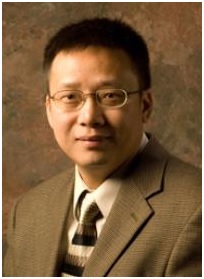 报告时间:2015年7月14日 14:00-15:30
报告时间:2015年7月14日 14:00-15:30报告地点:曹光彪大楼326
主讲人:杜金成副教授
邀请人: 乔旭升副教授
Dr. Jincheng Du is an associate professor from Department of Materials Science and Engineering, University of North Texas.
He and his research group focuses on computational and materials modeling methods to understand the structure and structural origin of properties of glass/amorphous and nanostructured materials. He is also interested in investigating defects, surfaces and interfaces and their effect on material properties for materials with microelectronic, energy, environmental, and biomedical applications.
Prof. Du’sgroup use simulation methods such as classical and ab initio molecular dynamics simulations, Density Functional Theory (DFT) calculations, and Monte Carlo simulations. His computational and modeling investigations are usually integrated or in close connection with experimental efforts, either in his own group or with collaborators. He is interested in developing empirical potentials for the modeling of oxide glass/ceramics and related materials, developing Reverse Monte Carlo and Kinetic Monte Carlo methods to study complex structures and chemical reactions.
报告题目:
Atomistic computer simulations of glass materials: the mixed glass former effect on the structure and properties of multicomponent oxide glasses
报告摘要:
Atomistic computer simulations have developed into an important field of glass research and become almost indispensible in understanding the structure and structure-property relationships of glass materials due to their amorphous nature and complex structures. In this seminar, Prof. Du will review the progresses of atomistic computer simulations of glasses and give examples of their application in several technologically important glass systems. The focus will be on the understanding the mixed glass former effect in oxide glasses, especially how different glass forming oxide interact with each other and influence the overall glass structure and properties. The first system he will present is the cerium aluminophosphate and phosphosilicate glasses, which contain more than one glass formers: phosphorus oxide, aluminum oxide or silica. These glasses can resist radiation induced color change and find applications in solar cell cover glass for land and space applications. The structure cerium doped glass as a function of glass former ratio and cerium doping level will be presented. Comparison of the simulated structure with high energy X-ray diffraction and other experiment results will be given. Reltionship of glass structure to radiation resistance will be discussed. The second system will be presented is sodium aluminosilicate glasses. These glass systems are the basis of the Gorilla glass that are widely used for display and other applications. Compositions ranging from peralkali to peralumina have been studied and the structure issues such as aluminum coordination and oxygen tricluster will be discussed. Lastly, the calculated mechanical properties of these glasses as a function of composition will be compared with experimental data and correlated to the obtained glass structure. Challenges of computer simulations of glasses and future directions will be presented.

